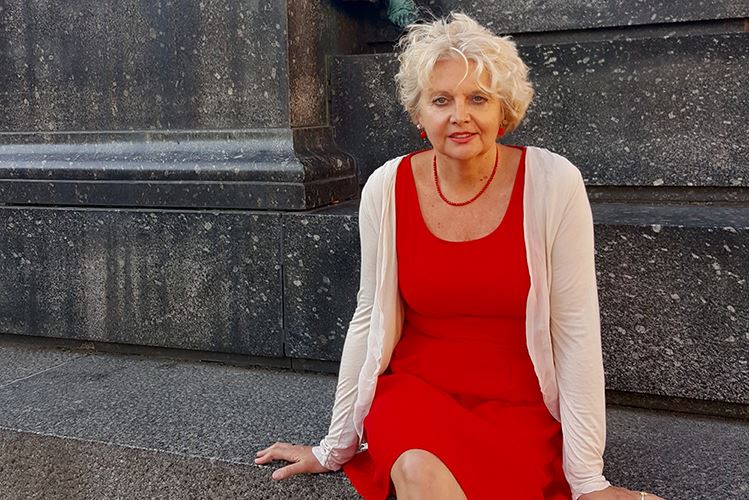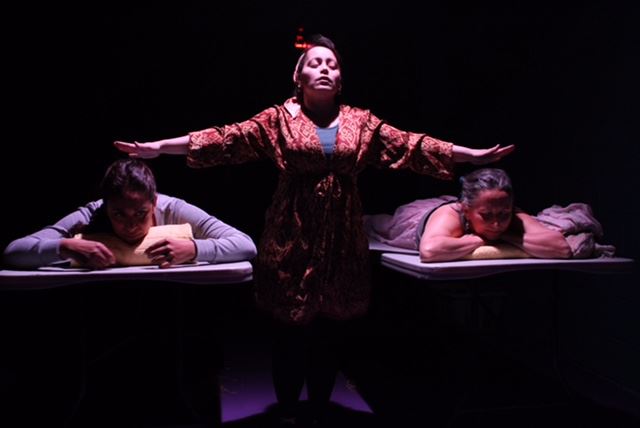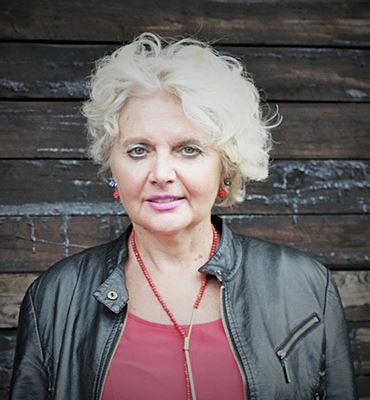Domnica Radulescu

I tell this story often and from different perspectives – the story about how theater saved my life in the early 1980s, during my last years in my native Romania, then a brutal dictatorship.
How it lifted me above the oppressive grayness filled with terror and myriads material and spiritual deprivations and it gave me a sense of purpose and even joy. This episode of my life never loses its relevance and over time it has acquired almost a life of its own.
Now I want to give it a different twist and look at it from the perspective of feminist aesthetics and connect it to some aspects of the American theater scene that I believe to be lacking.

Exile Is My Home. A Sci-fi Immigrant Fairy Tale, by Domnica Radulescu. The Theater for the New City, New York, NY. April 28-May 22, 2016. Directed by Andreas Robertz. Original music score by Alexander Tanson. pictured clockwise from left: Nikaury Rodriguez, Mirandy Rodriguez, Noemi De la Puente. Photography – OneHeart Productions
In my second year as a student at the University of Bucharest, I joined a theater called The Attic, because it was housed literally in the attic of the headquarters of the Romanian Communist Youth, and whose artistic director modeled the practice on the work of Polish director Jerzy Grotowski and his Poor Theater.
I played several small parts in different plays, some Romanian, others in translation. But the one experience that changed my life in profound ways and has stayed with me throughout both my personal and professional life as teacher and creative artist is a production of Samuel Beckett’s Happy Days whose female protagonist, Winnie, is buried to her waist in a mound of earth during the first Act and up to her neck in the second Act.
This was supposed to be a women’s project that the artistic director had entrusted his assistant director to develop with a group of the women actors in the theater, including myself. However, we were four women actors, and there is only one female protagonist.
That didn’t prevent our female director, to divide Winnie’s character into four different characters, each representing a different facet of the role. We did away with the mound of earth both from practical and artistic reasons. We made the play our own and attempted to suggest Winnie’s entrapment through other stage means, such as stacking chairs around the actors at different times. 
Foreign literature in translation trickled into our highly censored state at a pretty good pace, escaping the scrutiny of the party and secret police particularly if it was in the genre of the absurd, or the surreal which Beckett’s play certainly is.
However, no other details of production from Western Europe reached us, so we had no idea of Beckett’s fierce strictness in terms of respecting his text to its last diacritic and stage direction. We wouldn’t have cared anyways. Living under so many rules, of which most were more absurd than the theater of the absurd itself, we delighted in breaking them any chance we had.
We practiced long hours into the night with irrepressible passion and engaged in what today would be called devised feminist theater, as actors and director, we all collaborated in bringing the final show to its premiere. To me the opening night and the shows we had afterwards were incandescent, freeing, transformative and they touched me for life.
Working with a group of women actors and a woman director in complete artistic collaboration, searching through our own personal experiences as women and bringing them to our different sides of the role, devising innovative stage actions allowed me to grow both as a woman and as an artist.
Now fast forward some three and a half decades later, to the person I am now: a university professor of Comparative Literature, theater director, playwright and novelist in the United States where I arrived as a political refugee in 1983. Theater has remained a constant and a life savior throughout all my years in this country.
I do not live in New York, considered the Mecca of American Theater, I no longer live in Chicago from where I moved 25 years ago to the small town in Virginia for a university job that I still hold to this day, but I have traveled copiously throughout the United States and different parts of the world.
Wherever I go I always look for theaters, shows, performances. I always carry Winnie with me in my carry on suitcase and I often use that experience as a measure of comparison to the other theatrical experiences I have, be it in New York, Paris, Chicago, Minneapolis, Belgrade, in my native Bucharest where I have been returning on a regular basis, or in smaller cities in the US or abroad.
I usually ask myself the same questions whenever I see a new show: is it theatrically innovative in ways which bring out to its fullest the potential of the actors’ bodies on stage, is the space used creatively, are there interesting, complex, multilayered female roles in it, are women’s bodies, voices, stories center stage?
I have of course assimilated much feminist and performance theory, since the Winnie in the Attic days when we couldn’t have cared less whether our show was feminist or not, as feminism was not even part of our daily vocabulary.
And much as Rita Anderson has beautifully articulated it in the previous blog article, “Fighting for a Female Sentence,” I too am always struggling to find, promote and/or create myself theater that not only brings center stage women’s experiences and voices in intersectional ways, but that equally embodies these voices in new aesthetics, a feminist aesthetics.
How a story is told is at least as important as what the story is about. Feminist theater aesthetics, with non-linear narratives and plots, with discourses emerging from woman “writing woman” and woman “writing her self,” and her body which “must be heard,”as Helene Cixous beautifully puts it in her “Laugh of the Medusa,” theatrical forms and languages quivering with feminist humor that subverts and bursts the self important bubbles of sexism and “upstage Big Daddy” of canonical discourses as Gay Gibson Cima has shown, languages which in the apt words of Judy Little “carnivalize the sentence,” and that choose “the margin as a space of radical openness” in the inspired words of bell hooks – all this is largely absent from main stream American Theater or an oddity at best.
The revered New York theater scene of the Broadway and off Broadway shows and musicals, or the main stream theaters of say Chicago, Washington DC, the likes of Steppenwolf or Arena Stage Theater still largely indulge in traditional theatrical forms, linear plots, stages filled to excess with a ballast of realistic sets and objects.

Exile Is My Home. A Sci-fi Immigrant Fairy Tale, by Domnica Radulescu. Pictured clockwise from left: Vivienne Jurado, A. B. Lugo, Nikaury Rodriguez, David van Leesten, Mirandy Rodriguez, Noemi de la Puente, Mario Golden. Photography – OneHeart Productions
There are a handful of New York theater spaces that have satisfied my appetite for such feminist innovative aesthetics and that are also affordable for most regular people, including the many striving artists of the city: Ellen Stuart’s brilliant creation of the La MaMa theater, the New York Theater Workshop, the Women’s Theater Project, or the Theater for the New City where I had the honor of having my own play Exile Is My Home. A Sci-fi Immigrant Fairy Tale produced under the startlingly creative and feminist direction of Andreas Robertz.
But these spaces and theater practices are still considered by the masses of theater goers as the “weird” shows, the “political” in the bad sense of the word shows in opposition to the “entertaining” ones. Their actors and directors are barely or not paid at all.

We All Have the Same Story, by Franca Rame, directed by Domnica Radulescu. National Theater of Cluj-Napoca, Romania, January 2009. Diana Rosca
To each Lynn Nottage, Paula Vogel or Susan Lori Parks that makes it to the top or in the center stages of American Theater, and very deservedly so, there are however scores of women theater artists whose works never get past a first round of readers who might consider their plays not “well-constructed” enough, or ‘strident” or “confusing,” and such readers, sadly often include women too.
It is not the playwrights and the theater artists that drive the market, it is the market that too often drives the art. And it is the same market that thus drives the public tastes and the theater education. Too often students’ only idea of theater when they first arrive into one of my theater or women and gender studies classes is either a Shakespeare play or a Broadway musical.
They are startled to discover lesser known, American or International theater works or forms of theater making: women’s monologues by Franca Rame, plays and performances by Deb Margolin, plays of Sarah Kane, the feminist DAH theater in Belgrade that emerged as a response to the genocidal war of the nineties, or one of my own plays.
At first they may be reluctant, shocked or even uneasy to enter into such disruptive, or zany universes which they sometimes call “all over the place” or “confusing.” With discussions and collaborative, devising work and techniques, they invariably end up inhabiting these universes with the joy of discovery.

The Presence of Absence; DAH Theater, Belgrade, directed by Dijana Milojevic; devised by DAH Theater Ensemble photos by Dijana Milojevic, October-December 2013.From left to right, clockwise: Maja Vukovic, Sanja Krsmanović Tasić, Nemanja Ajdačić (man with violin, also composer of violin music). An example of DAH Theater’s ability to create visually startling moments and even beauty while bearing witness to the grief caused by the disappearance of people and the need of survivors to tell their stories.
In the darkest years of Communist Romania, we created our Winnie show with only a few of the chairs that were our only movable set pieces in the theater, with sheets, props and costumes we found among our own meager possessions.
Yet, the entire experience felt rich, enriching, incandescent and glorious. Andreas Robertz, directed my play in the smallest basement theater space of the iconic Theater for the New City, on “a shoe string,” as the saying goes, with minimal set, but with extraordinary actors and inventiveness, bringing out the best of the feminist theater languages of my play.
He made sure the cast embodied the very diversity of my characters and created a universe in which the margins became “spaces of radical openness,” as my two protagonists, a lesbian couple, traversed the galaxies and dystopian landscapes, some very similar to our own earthly spaces, in desperate search for a home.
When the play opened, three years ago almost to the day, I was the same age as the Winnie I had played as a young woman. I would have never imagined then that our production would remain a model of theatrical inventiveness, and feminist art, or that one day my own play would be produced in a very similar manner in no other than New York City, but that such experimentation is to this day more of a rarity than a common occurrence in the theater world.
Were we ahead of our time out of desperation, or is the American art world slow if not stagnant in terms of allowing ex-centric forms and voices to have a full seat at the table?
I honestly do not know how to answer these questions in ways that would not lead me to either hopelessness or anger. But I do know that if I keep listening to Winnie’s urges I can at least get solace and by achieving even temporary solace, I can keep going, fighting, singing in my own voice.
"No, something must move, in the world, I can’t any more. A zephyr. A breath. I hear cries. Sing. Sing your old song, Winnie. Ah well, what matter, that’s what I always say, it will have been a happy day, after all, another happy day.” (Samuel Beckett, Happy Days!)

Domnica Radulescu is an American writer of Romanian origin, living in the United States where she arrived in 1983 as a political refugee. She has chosen English as the language of her written expression in all her nonfiction, fiction and dramatic works.
She lives, functions and writes in the hyphenated spaces between cultures, languages and artistic universes. She is the author of three critically acclaimed novels, Train to Trieste (Knopf 2008 &2009), Black Sea Twilight (Transworld 2011 & 2012) and Country of Red Azaleas (Hachette 2016) and of award winning plays, of which Exile Is My Home was produced off off Broadway, at the Theater for the New City in New York, in 2016 and received the Outstanding Performance by an Ensemble Cast Award from the Hispanic Organization of Latin Actors.
Her first novel Train to Trieste was translated into thirteen languages and received the Best Fiction Award from the Library of Virginia in 2009. She is twice a Fulbright scholar and winner of the 2011 Outstanding Faculty Award from the State of Virginia.
She is Distinguished Service Professor of Comparative Literature at Washington and Lee University in Lexington, Virginia.
http://www.domnicaradulescu.com/
https://en.wikipedia.org/wiki/Domnica_Radulescu
![]() at the top of the post
at the top of the post![]() at the top of the post
at the top of the post